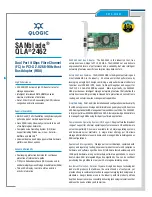
WiSnap User Manual 2.21 04112011-JF
Page
11
of
66
Remote configuration using AD-HOC mode
Using ad-hoc mode to configure the device eliminates the need for the module to be associated with
a network access point. In ad-hoc mode the module creates it own “on demand” network that you
can connect to via your computer like you would to any other network.
To enable ad-hoc mode via hardware, set
PIO9
high (3.3V) at power up. On the WiSnap M1, PIO9 is
on the J1 jumper block, and dipswitch 1 on the WiSnap AAA. When the module powers up with PIO9
set high, the WiSnap module creates an ad-hoc network with the following
SSID:
WiSnap-XX - where XX is the final two bytes of the device’s MAC address
Channel:
1
DHCP:
OFF
IP address: 169.254.1.1
Netmask:
255.255.0.0
With the ad-hoc jumper in place, the above settings override the saved software configuration
settings.
From your computer or smartphone, connect to the WiSnap-XX network. This is an open network
which does not require a pass phrase or pass key.
NOTE:
currently the WiSnap only supports OPEN mode for creating ad-hoc networks.
NOTE:
It may take a couple of minutes for Auto IP in Windows to assign an IP address and connect
to the network. You can check IP address of your Windows computer by running the
ipconfig
command in a command window. If connected, this command will show you the IP address and
netmask for your computer.
Your IP address must be on the 169.254.x.y subnet otherwise the WiSnap module will not be
accessible.
NOTE:
If your machine has both a wireless and wired network interface, you may need to disable
the wired LAN interface hardware before connecting to the ad-hoc network. If the wired LAN is
enabled, the computer may assign an IP address that is not on the same subnet as the WiSnap
module.
Once connected and you have a valid IP address, telnet into the WiSnap module on port 2000 with
this command in Windows:
telnet 169.254.1.1 2000
You should see the response “*HELLO*”
You can now enter command mode and configure the module.
3.2
Common Configurations
Two common modes of operation for the WiSnap module are A) initiating a connection to a server
and B) listening for a remote host connection. This section will go through the configuration for each
setup. The setups are shown using infrastructure network. i.e. with an access point, however the
same can be done with ad-hoc networking.
Initiating a connection from the WiSnap
Step 1: Set up the WLAN properties so the device will connect to the network automatically upon power up. In this
example we want to connect to the wireless network my_network.











































